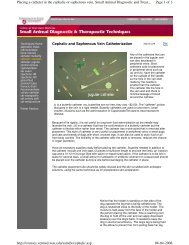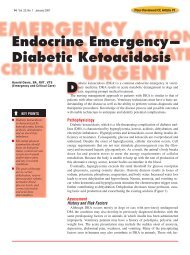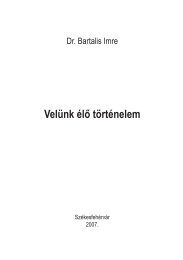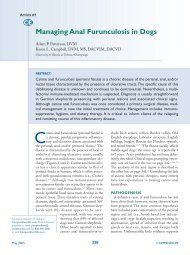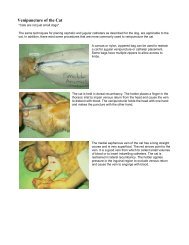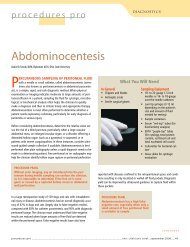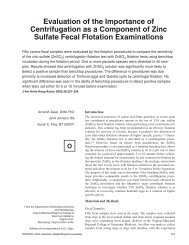evaluating blood films evaluating blood films - Hungarovet
evaluating blood films evaluating blood films - Hungarovet
evaluating blood films evaluating blood films - Hungarovet
- No tags were found...
You also want an ePaper? Increase the reach of your titles
YUMPU automatically turns print PDFs into web optimized ePapers that Google loves.
ated RBC regeneration. In healthy animals, thelow numbers of RBCs with Howell-Jolly bodiesreleased from the bone marrow are quicklyremoved from circulation primarily throughthe action of fixed tissue macrophages in thespleen. If Howell-Jolly bodies are easily identifiedand no reticulocytosis is noted, investigateunderlying splenic disease. This inclusioncan be an incidental finding in catsbecause of the open splenic architecture anddecreased erythrophagocytic properties inherentto the feline spleen.Infectious agents including Babesia (Figure14), Cytauxzoon, and Mycoplasma (previouslyknown as Haemobartonella) speciesmay be identified in RBCs. Evaluation for Mycoplasmaspecies (Figure 15) should be performedon freshly collected <strong>blood</strong> samplesthat have not been refrigerated to improveidentification.Evaluating the plateletsAre platelet numbers normal,decreased, or increased?Microscopic validation of platelet counts isan important component of <strong>blood</strong> film evaluation.Platelet clumping (Figure 16 ) interfereswith accurate enumeration of plateletswith all hematology analyzers and with manualcounting methods. Clumping occurs inmany samples because of platelet activationduring the collection process. Increasednumbers of large platelets may also result ininaccurate platelet counts when impedanceFIGURE 14counting methods are used.On a well-prepared peripheral <strong>blood</strong> filmin which no marked platelet clumping at thefeathered edge is present, the average numberof platelets observed per 100 oilimmersionmonolayer field multiplied by20,000 provides a good estimate of the numberof platelets/µl. As a general rule, youshould see a minimum of eight to 10 plateletsand a maximum of 35 to 40 platelets per100 oil-immersion monolayer field ofview. 9If the platelet numbers are decreased,can the mechanismbe determined?Thrombocytopenias occur through fourbasic mechanisms: sequestration, utilization(consumption), destruction, and decreased orineffective production. While clues as to theunderlying mechanism are found in the CBC,in most cases, bone marrow evaluation isneeded for complete interpretation.Sequestration thrombocytopenias are uncommonin veterinary medicine. They areusually the result of hypersplenism and,thus, are characterized by an enlargedspleen on physical or radiographic examination.Utilization, or consumption, thrombocytopeniasare caused by excessive activation ofthe coagulation cascade. These thrombocytopeniasare associated with inflammatory diseaseand DIC. Utilization thrombocytopeniasare usually moderate, with platelet numbersFIGURE 15in the 75,000 to 150,000/µl range, but valuesbelow 40,000/µl accompanied by petechiaeare possible. 10 Bone marrow evaluation revealsnormal to increased numbers ofmegakaryocytes.Destruction thrombocytopenias are immune-mediatedthrombocytopenias in whichnormal circulating platelets are destroyed bycirculating antiplatelet antibodies. Destructionthrombocytopenias are often extreme, with peripheralplatelet counts well below 50,000/µl.Bone marrow examination is characterized bynormal to increased numbers of megakaryocytes.Decreased or ineffective production is associatedwith extremely low platelet counts;counts well below 50,000/µl are common.Bone marrow evaluation will vary greatly inmost of these cases, although they will sharesimilar end results of deceased effective productionby the bone marrow. With decreasedproduction thrombocytopenias, no identifiableto extremely low numbers of megakaryocytesare present. With ineffective production, mostbone marrow samples have normal to increasednumbers of megakaryocytes, and theproduction of platelets is ineffective in manycases because of an immune-mediated destructiveprocess directed at an early stage ofplatelet development or at the megakaryocytepopulation itself.FIGURE 1614. Babesia canis (arrow) in a dog (modified Wright’sstain; 100).15. Mycoplasma haemocanis (arrow) in a dog (modifiedWright’s stain; 100).16. A <strong>blood</strong> film from a cat showing clumped platelets(arrow) (modified Wright’s stain; 20).12





